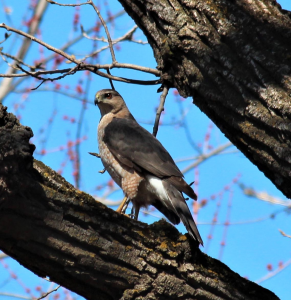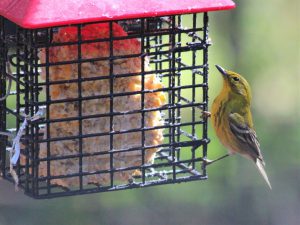Posted 12/13/18
Accipiter hawks that have colonized and persisted in Chicago are mainly in areas of high prey abundance. Sofia Kozidis is interested in determining if this pattern holds true for other large urban areas and will be using Project FeederWatch data to accomplish this task. More than 20,000 people participate in project FeederWatch, which has been ongoing since 1987, giving scientists such as Sofia the ideal dataset to work with since the data covers a wide geographic area and a long period of time.

The effect of urbanization on wildlife is varied; some species adapt to urbanization, and others do not. For accipiter hawks, urbanization might not be all that bad. By combining remote sensing with citizen science, UW-Madison researchers recently found that in Chicago, increases in imperviousness and tree cover reduced the probability of colonization of urban areas by accipiter hawks, while increases in prey abundance (i.e. songbirds) increased the probability of colonization. In addition, the stabilization of urbanization coincided with a leveling off of hawk occupancy. These recent findings can help scientists understand how wildlife may respond and adapt to urbanization in other areas. To see if these trends reoccur in urban environments in very different biomes, Sofia Kozidis will conduct research that expands upon the Chicago findings to improve understanding of how avian predators respond to urbanization over a larger range of conditions. She will expand the area of study from one urban area, Chicago, to other major urban areas that have high accipiter hawk occupancy and a wealth of Project FeederWatch data.

Project FeederWatch is a citizen science project in which participants count the birds visiting their backyard bird feeders periodically between November and April. This data is used by scientists to track long-term trends in winter bird distribution and abundance. Using FeederWatch data from 1996 to 2018, Sofia will identify occupancy patterns in urban areas that have a high abundance of accipiter hawks while also seeking to assess impacts of hawk’s presence on songbird populations. The expectation is that, as was found in Chicago, accipiter hawk occupancy will increase over time. However, it is possible that colonization and occupancy patterns could differ between cities depending on factors such as climate, city layout, and the surrounding environment. If patterns in certain urban areas differ from the expectation, Sofia will analyze those areas using remote sensing tools to see if she can determine factors associated with unexpected patterns, ultimately helping to elucidate the range of responses of accipiter hawks to urbanization. Sofia’s research highlights the usefulness of citizen science projects, which generates larger amounts of data than could be collected by one researcher alone and connects citizens to scientific research.
Story by Olah, Ashley
